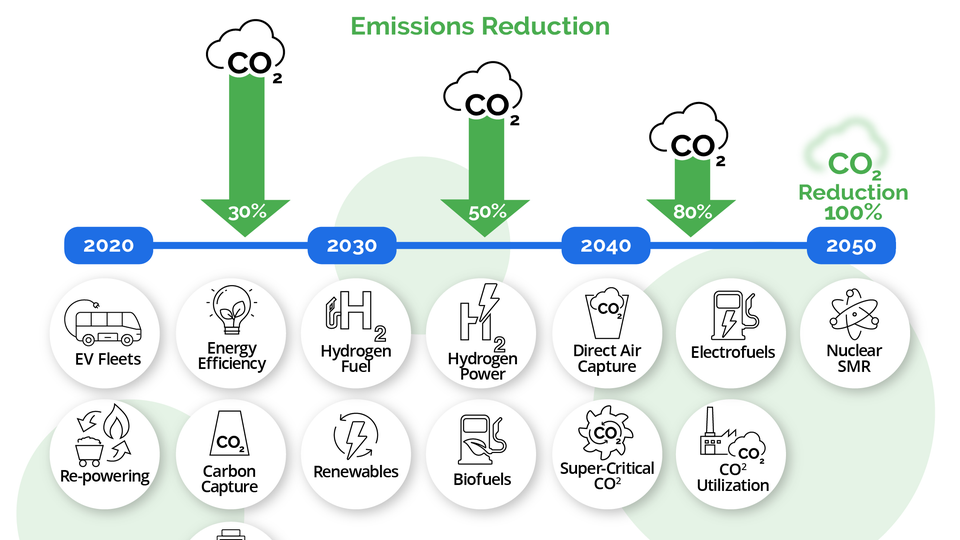Building a roadmap to decarbonization
Building a roadmap to decarbonization


Authored by: Jim Spenceley, Jason Rowell, Victoria Gosteva and Algert Prifti
Mirroring the evolution of the Industrial Revolution, the journey of scientific exploration of climate change issues began in the early 19th century. A hundred years later, in the 1930s, Thomas Edison voiced concerns about climate change and highlighted the need for renewable energy. Another century later, the need for action to address global climate change is as pressing as ever.
For today’s global mining industry, there’s no doubt about the future destination: all signs point to decarbonization. Mining companies have increasingly embraced a lower-carbon, if not carbon-free, future. But even though decarbonization is the end goal, there is no one “right” way to get there; miners have multiple options and a suite of technologies from which to choose. No one single technology works equally well in all mines, in all regions. For example, the needs of a planned iron ore mine in Australia could differ significantly from an operating copper mine in Chile.
Most countries in the world have taken part in a united approach to solve the global climate problem. Joining these efforts, the investor community has increased its expectation that miners, among other sectors, take more aggressive steps to decarbonize. The Climate Action 100+ coalition, an investor initiative launched in 2017 with more than 450 investors and over $40 trillion in assets collectively under management are engaging companies to curb emissions, improve governance and strengthen climate-related financial disclosures. Some of the mining majors participate in the Coalition to drive the clean energy transition.
BlackRock, an asset-management firm with approximately $7 trillion under management, earlier this year said it would “place sustainability at the center of our investment approach” by, among other things, recalibrating their investment portfolio to address their clients’ concerns: “Our investment conviction is that sustainability and climate-integrated portfolios can provide better risk-adjusted returns to investors.”
Many mining companies are actively taking steps to reduce GHG emissions and plan for long-term decarbonization of their operations. In early 2020, the International Council on Mining and Metals (ICMM) released an enhanced set of mining principles that obligate members to “pursue continual improvement in environmental performance issues, such as water stewardship, energy use and climate change.” Twenty-seven of the world’s largest mining companies are members of the ICMM.
Climate change and related environmental issues were named as the top five risks by the World Economic Forum for 2020—the first time in the survey’s history that one category has occupied all five of the top spots. In their Top 10 Business Risks facing mining and metals for 2020, Ernst & Young placed License to Operate at the top and Reducing Carbon Footprint in fourth place. BHP’s CEO Mike Henry commented on “Social Value” to operate as one of the main drivers in the company’s decision making, and, referencing climate change as an example, shared that “Later this year, we’ll announce a commitment to the market with an updated 2030 science-based target for Scope 1 and Scope 2 emissions that align with the Paris Agreement … In addition to this being a relevant issue from a values perspective, it’s also going to hit the bottom line of everybody at BHP in a bigger way than it has in the past.”
Mining is inherently energy-intensive with a large carbon footprint, and a mine spends a significant percentage of its operating costs on energy. These days, energy strategy for miners includes not only finding the lowest-cost sources of energy, but also solutions that support carbon reduction goals. Miners face a complex array of forces — financial, shareholder, technological, political, regulatory, legal and social — driving the need for decarbonization; so how should mining companies proceed?
Decarbonization strategies require the long view. Proper planning involves a horizon that is decades away, requiring visibility into technology maturity and associated costs to avoid getting locked into path dependency or stranding assets. Miners are looking to develop comprehensive energy strategies and long-term decarbonization roadmaps that focus on evaluating competing conventional and emerging technologies, and de-risking their path to Net Zero.
Building a roadmap to decarbonization

Today, miners have more technology-based alternatives than ever before when it comes to decarbonization. They can evaluate and deploy a variety of low- and zero-carbon energy sources such as renewables, (e.g., large-scale solar and wind, electric vehicles, low-carbon fuels and hydrogen), paired with associated technologies such as battery storage and fuel cell technology. From there, other emerging technologies come into play – such as hydrogen power, direct air capture, electrification and advanced nuclear power. Miners seek to evaluate the trade-offs of these technologies to ensure that a cost-effective, reliable pathway to Net-Zero is achieved.
These measures will get the industry part of the way there. But to fully achieve Net Zero, miners – and the world in general – will need to embrace technologies that are not yet fully developed. Miners can sustainably achieve their carbon reduction goals through the development of tailored road maps that focus on successful investments and implementations of new and existing technology solutions that best align with their operational needs and corporate objectives.
When it comes to decarbonization, miners are facing a significant energy transition and there are a plethora of technologies and solutions to be considered for their tailored road maps. There will be best practices to adopt, sharing learnings across industries as well as innovations to avoid.
About the authors:
Jim Spenceley, Senior Vice President - Mining
Jason Rowell, Global Technology Manager - Power
Victoria Gosteva, Marketing and Business Development Lead - Mining
Algert Prifti, Decarbonization and Carbon Capture, Sequestration and Utilization